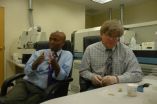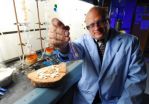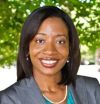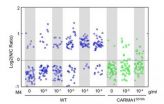(Press-News.org) Scientists have created a 'heavy' mouse, the world's first animal enriched with heavy but non-radioactive isotopes - enabling them to capture in unprecedented detail the molecular structure of natural tissue by reading the magnetism inherent in the isotopes.
This data has been used to grow biological tissue in the lab practically identical to native tissue, which can be manipulated and analysed in ways impossible for natural samples. Researchers say the approach has huge potential for scientific and medical breakthroughs: lab-grown tissue could be used to replace heart valves, for example.
In fact, with their earliest research on the new in vitro tissue, the team have discovered that poly(ADP ribose) (PAR) – a molecule believed to only exist inside a cell for the purpose of repairing DNA – not only travels outside cells but may trigger bone mineralisation.
"It was crazy to see PAR behaving in this way; it took six months of detailed analysis and many more experiments to convince ourselves," said Dr Melinda Duer from Cambridge's Department of Chemistry, who led the study, published today in the journal Science.
"I think this is just the first of many discoveries that will stem from the heavy mouse. Isotope-enriched proteins and cells are fairly commonplace now, but the leap to a whole animal is a big one.
"The heavier nuclei in the carbon isotopes changes the rate of chemical reactions, and many people – myself initially included – didn't believe you could enrich a whole animal with them. But it worked beautifully," she said.
The research, funded by the Biotechnology and Biological Sciences Research Council and British Heart Foundation, could lead to improved success rates for medical implants and reduce the need for animals in research, as well as opening up an entirely new approach for biochemical investigation.
The team used a technique called Nuclear Magnetic Resonance spectroscopy (NMR) that can read the magnetic nuclei found in certain isotopes, such as carbon-13 – which has one neutron more than most carbon.
But carbon-13 makes up only 1% of the carbon in our bodies, nowhere near enough to do useful NMR. However, the researchers managed to get the carbon of a mouse up to 20% carbon-13.
So how do you make a heavy mouse? Perhaps obviously, you feed it a lot. "We used mouse feed rich in carbon-13 and let the mouse eat as much as it liked," said Duer. "It sounds strange, but no one had thought to do it before. Maybe everyone had assumed it wouldn't work, I certainly got some odd looks from colleagues."
Using NMR analysis of the mouse tissue to map the distance between the carbon atoms and reveal atomic structures, researchers were able to create a 'gold standard' reference for growing tissue in the lab – a fingerprint of the atomic networks that are the basis of proteins in our biology.
The team shared this with scientists Rakesh Rajan and Dr Roger Brooks in the Division of Trauma and Orthopaedic Surgery at the University's Department of Surgery, who used the Duer group's NMR 'spectra' maps to refine cell cultures and produce exceptional lab-grown tissue that looks near identical to real tissue.
When comparing microscopy images of the new lab-grown tissue with native tissue, Duer says she has yet to find a biologist who can tell the difference. "We found that once you get it right at a molecular level, the rest looks after itself," she said.
The new techniques allow scientists to go beyond the nanoscopic, which has been the limit for tissue analysis, and into the atomic. "We could see signals in the NMR data for our lab-grown tissue, extra intensities that – when matched with the heavy mouse data – revealed where proteins hadn't folded up properly," said Brooks.
This kind of 'misfolding' is almost impossible to detect through microscopes, but could result in host rejection if the tissue were to be implanted. "Through a process of repeat NMR comparisons we were able to modify the lab tissue until it looked near identical with NMR and under the microscope," explained Brooks.
Not only have the researchers developed these techniques, they also managed to strike scientific gold during some of their first experiments on lab-grown tissue matched to the heavy mouse.
Using bone-forming cells, the group grew collagen tissue in the lab to look at how bone is developed. While using the new method to look for sugars, they found signs of molecules that shouldn't be there – the closest thing these molecules resembled was DNA.
After further research, the team were forced to reach a very surprising conclusion: the molecule was poly(ADP ribose), or PAR, previously only thought to be found inside cells where its purpose in life is flagging damaged DNA for repair.
"Not only is PAR there, and leaving the cells entirely, but once it's in the surrounding matrix it's perfectly designed to start pulling together the calcium and phosphate that make up bone crystals," explained Duer.
This is happening at the exact same time the cells start laying down the organic matrix to house the mineral crystals that form bone, says Duer. In the intervening six months, a staining test for PAR had been developed, so the team checked again on bone growth taken straight from the animal.
"When the results came back, even I couldn't believe it! The bone tissue was stained everywhere," said Duer.
The team had discovered that the molecule listed in all the textbooks as the deft surgeon of DNA also moonlights as an engine of bone production.
"The fact that we are already making such remarkable discoveries using the techniques that have been developed as a result of the heavy mouse is hugely exciting, and shows the enormous potential of this approach," said Duer.
"We're now looking at blood vessels to see if lab-grown tissue could be used for replacement arteries and heart valves - and to see if we can find the molecules that trigger calcification of the arteries, as well as calcification of bone."
"One mouse on a specific diet might end up rewriting the textbooks."
INFORMATION:
First 'heavy mouse' leads to first lab-grown tissue mapped from atomic life
2014-05-15
ELSE PRESS RELEASES FROM THIS DATE:
One of oldest human skeletons in North America is discovered
2014-05-15
Cave-diving scientist Patricia A. Beddows of Northwestern University is a member of an international team of researchers and cave divers this week announcing the discovery in an underwater Yucatán Peninsula cave of one of the oldest human skeletons found in North America.
Details of "Naia," a teenage girl who went underground to seek water and fell to her death in a large pit named Hoyo Negro ("black hole" in Spanish), will be published May 16 in the journal Science.
"The preservation of all the bones in this deep water-filled cave is amazing -- the bones are beautifully ...
Communicating with the world across the border
2014-05-15
Stanford, CA—All living cells are held together by membranes, which provide a barrier to the transport of nutrients. They are also the communication platform connecting the outside world to the cell’s interior control centers. Thousands of proteins reside in these cell membranes and control the flow of select chemicals, which move across the barrier and mediate the flux of nutrients and information. Almost all of these pathways work by protein handshakes--one protein “talking” to another in order to, for example, encourage the import of a needed nutrient, to block a compound ...
Quantum simulator gives clues about magnetism
2014-05-15
Assembling the puzzles of quantum materials is, in some ways, like dipping a wire hanger into a vat of soapy water, says CIFAR (Canadian Institute for Advanced Research) Fellow Joseph Thywissen (University of Toronto).
Long before mathematical equations could explain the shapes and angles in the soap foams, mathematicians conjectured that soap films naturally found the geometry that minimized surface area, thus solving the problem of minimal surfaces. They could be created simply by blowing soap bubbles.
At the University of Toronto's Ultracold Atoms Lab, Thywissen ...
UNM plays major role in establishing link between ancient and modern Native-Americans
2014-05-15
Her name is Naia, and for thousands and thousands of years, the skeleton of this young woman was buried underwater in an elaborate cave system in the Yucatan Peninsula after she had apparently fallen into what was then a dry deep pit.
Now, a team of researchers, including Professor Yemane Asmerom and Research Scientist Victor Polyak at the University of New Mexico's Department of Earth and Planetary Sciences, have accurately determined the age of the oldest-known, well-preserved human skeleton. Naia was one of the earliest inhabitants of the Americas and has helped resolve ...
Making money from lignin: Roadmap shows how to improve lignocellulosic biofuel biorefining
2014-05-15
When making cellulosic ethanol from plants, one problem is what to do with a woody agricultural waste product called lignin. The old adage in the pulp industry has been that one can make anything from lignin except money.
A new review article in the journal Science points the way toward a future where lignin is transformed from a waste product into valuable materials such as low-cost carbon fiber for cars or bio-based plastics. Using lignin in this way would create new markets for the forest products industry and make ethanol-to-fuel conversion more cost-effective.
"We've ...
UH researchers find definitive evidence of how zeolites grow
2014-05-15
Researchers have found the first definitive evidence of how silicalite-1 (MFI type) zeolites grow, showing that growth is a concerted process involving both the attachment of nanoparticles and the addition of molecules.
Both processes appear to happen simultaneously, said Jeffrey Rimer, an engineering professor at the University of Houston and lead author of a paper published Thursday in the journal Science.
He said a second component to the research could have even more lasting impact. He and researcher Alexandra I. Lupulescu used a new technique allowing them to view ...
Anti-craving drug and counseling lower alcohol harm in homeless, without sobriety demands
2014-05-15
Chronically homeless, alcohol-dependent individuals might benefit from a new intervention that does not require them to stop or even reduce drinking, according to the results of a preliminary study in Seattle.
Participants in the 12-week pilot program received monthly injections of an anti-craving medication, extended-release naltrexone. They also met regularly with study physicians to set their own goals for treatment and to learn to be safer in their use of alcohol.
"Abstinence-based alcohol treatment has not been effective for or desirable to many homeless people ...
UTHealth research: Children of parents in technical jobs at higher risk for autism
2014-05-15
HOUSTON – (May 15, 2014) – Children of fathers who are in technical occupations are more likely to have an autism spectrum disorder, according to researchers at The University of Texas Health Science Center at Houston (UTHealth).
The findings will be presented Friday at the International Meeting for Autism Research in Atlanta.
During participation in the LoneStar LEND program, first author Aisha S. Dickerson, Ph.D., a researcher at UTHealth's Center for Clinical and Translational Sciences, used the United States government's Standard Occupational Classification system. ...
B cells produce antibodies 'when danger calls, but not when it whispers'
2014-05-15
The immune system's B cells protect us from disease by producing antibodies, or "smart bullets," that specifically target invaders such as pathogens and viruses while leaving harmless molecules alone. But how do B cells determine whether a threat is real and whether to start producing these weapons?
An international team of life scientists shows in the May 16 issue of the journal Science how and why these cells respond only to true threats.
"It is critical for B cells to respond either fully or not at all. Anything in between causes disease," said the study's senior ...
Researchers show emissions from forests influence very first stage of cloud formation
2014-05-15
PITTSBURGH—Clouds play a critical role in Earth's climate. Clouds also are the largest source of uncertainty in present climate models, according to the latest report of the Intergovernmental Panel on Climate Change. Much of the uncertainty surrounding clouds' effect on climate stems from the complexity of cloud formation.
New research from scientists at the CLOUD (Cosmics Leaving OUtdoor Droplets) experiment at CERN, including Carnegie Mellon University's Neil Donahue, sheds light on new-particle formation — the very first step of cloud formation and a critical component ...







